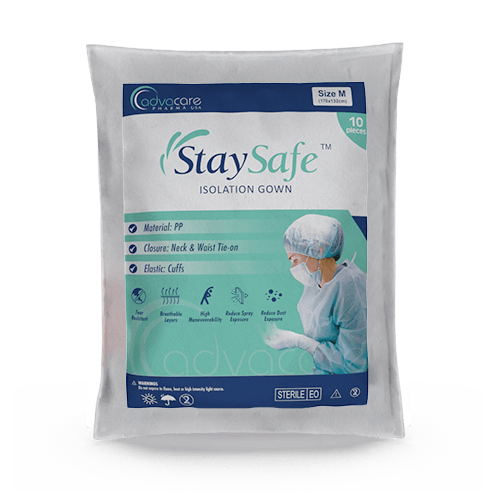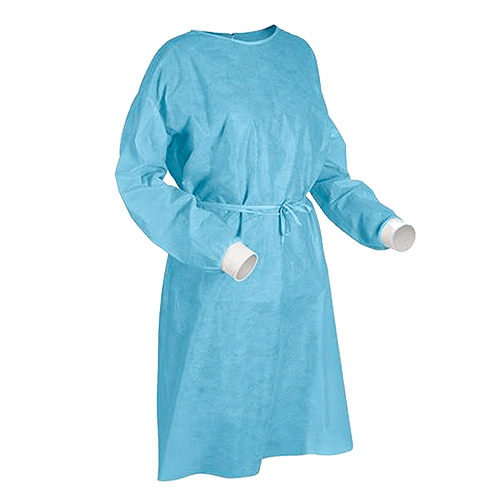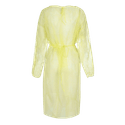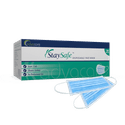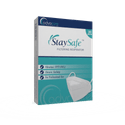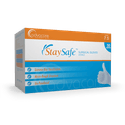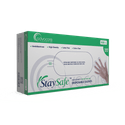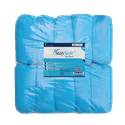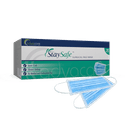Isolation Gown
Material
Fluid Protection
Collar Closure
Waist Closure
Cuff
Weight
Size
Color
Packaging
What is an Isolation Gown?
Isolation Gowns are personal protective equipment (PPE) used to protect the wearer from exposure to bodily fluids, infectious materials, and other possible contaminants. This type of garment is designed to be utilized in healthcare settings and is a vital part of infection control practices.
There are two main materials used in the production of disposable isolation gowns: PP (polypropylene) and SMS (spunbond-meltblown-spunbond). PP is a material that provides basic protection, while SMS provides better breathability and increased protection against fluids. Isolation gowns are available as standard gowns or reinforced gowns, which offer a higher level of resistance to penetration by bodily fluids.
These disposable gowns are highly customizable, as they can be equipped with a tie-on or Velcro collar closure and knitted or elastic cuffs. Weight options range from 28gsm to 45gsm, and sizing ranges from S to XXL.
Isolation Gowns are manufactured by AdvaCare Pharma, a reputable pharmaceutical company with expertise in global distribution. This medical disposable product is carefully produced in a CE/ISO-certified facility situated in China, India, and the USA. These facilities are routinely inspected to ensure our products meet health, safety, and environmental standards.
Product Specifications
Material
Fluid Protection
Collar Closure
Waist Closure
Cuff
Polypropylene (PP)
Polypropylene (PP) isolation gowns are composed of polypropylene, which is a durable and lightweight material. This material is waterproof and able to protect the wearer from liquids and fluids. Additionally, PP provides chemical resistance, ensuring an added layer of protection against potentially harmful substances and contamination. It is suitable for settings where protection from fluids and chemicals is crucial.

Spunbond-Meltblown-Spunbond (SMS)
Spunbond-Meltblown-Spunbond (SMS) isolation gowns are composed of a three-layered material of meltblown and spunbond fabrics. This combination of materials offers a higher strength and durability to the gown.
The meltblown layer has been specially added to act as a barrier against bacteria, which increases the garment's effectiveness in preventing the transmission of infectious agents.
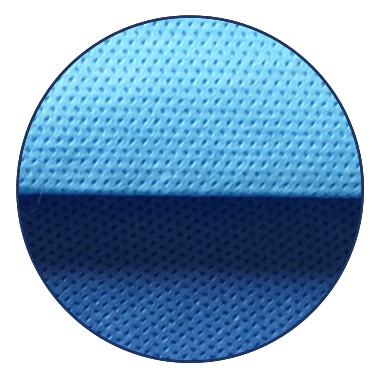
Reinforced
Reinforced isolation gowns are specifically designed to provide additional strength compared to standard PPE. The gowns are manufactured from reinforced polypropylene (PP) or spunbond-meltblown-spunbond (SMS).
Reinforced isolation gowns are particularly useful in surgical settings when an extra level of protection is required. It is important to note that patients typically do not need to wear this type of hospital gown.
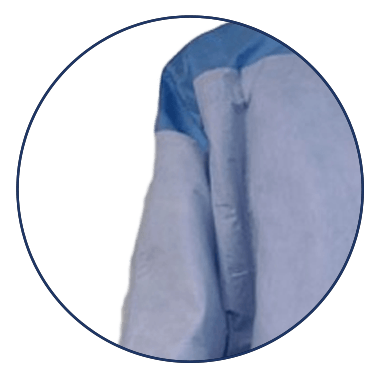
Tie-on
Tie-on collar closures feature long fabric straps that can be tied at the back of the neck. This allows for a secure and adjustable fit.
The tie-on collar closures offer flexibility in sizing and can accommodate a wide range of neck sizes. This closure style also allows for easy donning and doffing of the isolation gown.

Velcro
Velcro collar closures utilize a convenient and adjustable fastening system that allows for a secure fit around the neck.
The adjustable nature of a velcro closure can allow for a customized fit while accommodating a wide range of neck sizes. This style of collar closure ensures a snug yet comfortable fit while also maintaining the integrity of the isolation gown during a medical procedure.

One Band
One Band waist closures feature a single band that wraps around the waist in order to secure the gown in place. This closure style provides a comfortable and adjustable fit.
The one-band design offers simplicity and efficiency and allows for the easy donning and doffing of the gown while ensuring proper coverage and protection during medical procedures. This style is a popular choice for healthcare professionals due to its ease of use.
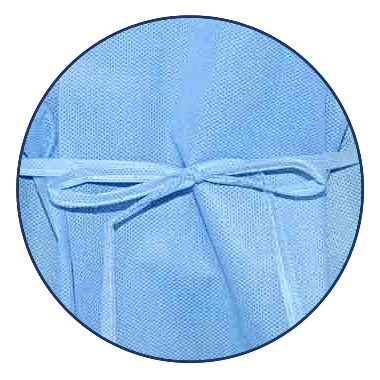
Four Bands
Four Bands waist closures feature four separate bands that wrap around the waist in order to secure the gown in place. This closure style offers enhanced stability while ensuring that the gown remains securely in place during medical procedures.
The four-band design accommodates a wider range of body sizes and is considered more comfortable, as the multiple bands more evenly distribute the tension and reduce pressure on the individual wearing the gown.
Isolation gowns with a four-band waist closure are preferred by healthcare professionals who prefer a snug and secure gown that offers optimal protection and ease of movement.

Knitted
Knitted cuffs are made of stretchable and soft fabric. The knitted cuffs offer a secure and comfortable fit around the wrists while also providing an added level of protection by creating a barrier that prevents contaminants from entering the sleeves. This feature is particularly important in healthcare settings where infection control is crucial.
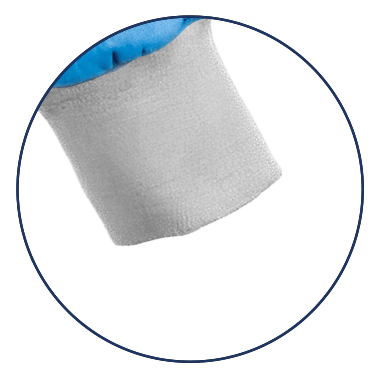
Elastic
Elastic cuffs are made of an elastic material that gives a secure and snug fit around the wrists. This style of cuff offer flexibility and stretchability which allows for easy donning and doffing of the gown. The secure fit provided helps to minimize the risk of contaminants entering the sleeves. The convenience of elastic cuffs is preferred by many healthcare professionals and workers in many industries.
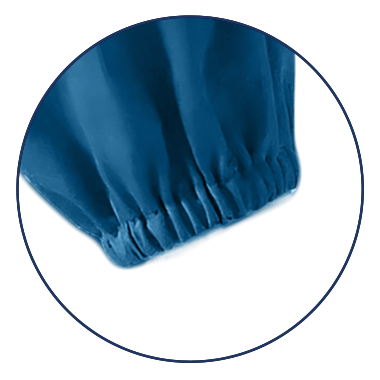
Why are we a trusted Isolation Gown manufacturer?
AdvaCare Pharma is a leading pharmaceutical company that excels in manufacturing Isolation Gowns and other top-tier single-use medical devices for protective use. We prioritize the production of high-quality, cost-effective PPE medical supplies. Our highly-skilled team works with our distributors to deliver customized solutions catering to the unique requirements of each market.
Over the past twenty years, we have established ourselves as a trusted and reliable exporter and manufacturer of Isolation Gowns and other medical disposables. Our partnerships include distributors, hospitals, pharmacies, and other many other institutions.
Uses
What are Isolation Gowns used for?
Isolation gowns serve as a protective garment designed to prevent the spread of infectious diseases and preserve a sterile environment. These gowns are primarily used in healthcare settings, laboratories, cleanrooms, and various other situations where individuals may come into contact with infectious materials, bodily fluids, or potentially harmful contaminants.
By creating a barrier between the wearer and potential hazards, isolation gowns assist infection control practices, safeguarding both healthcare professionals and patients.
How is an Isolation Gown worn?
How to wear an isolation gown:
- Start by thoroughly washing the hands.
- Then select the appropriate size of isolation gown so that it covers the body from the neck to below the knees.
- The gown can be secured at the back using tie-on or Velcro closures, or at the waist using one-band or four-band closures, depending on the gown's design.
- A visual inspection should be carried out to check for any defects or damage in the gown.
- If any flaws are identified, the gown should be immediately discarded to maintain the gown's integrity.
How should unused Isolation Gowns be stored?
Unused isolation gowns should be stored in a clean, dry, and well-ventilated area. Shield them from direct sunlight, heat sources, chemicals, and moisture, as these factors can compromise the gown's quality and protective properties.
To prevent contamination and retain the integrity of the gowns, it is recommended to store them in their original packaging or in a suitable container specifically designated for this purpose.
How should used Isolation Gowns be disposed of?
The proper disposal of used isolation gowns is required to uphold infection control standards. Healthcare facilities typically have established protocols and regulations for the disposal of medical waste, including used isolation gowns.
Depending on the specific guidelines and local regulations, used isolation gowns may be treated as medical waste and disposed of accordingly.
Are Isolation Gowns reusable?
Isolation gowns are designed for single-use to conserve their efficacy and prevent the potential spread of contaminants. Reusing isolation gowns may compromise their protective properties.
What is the difference between PP and SMS Isolation Gowns?
PP (polypropylene) isolation gowns are lightweight, cost-effective, and offer basic defence against fluids and contaminants. SMS (spunbond-meltblown-spunbond) isolation gowns, on the other hand, give further breathability and fluid resistance. The SMS material consists of multiple layers, including a meltblown layer that acts as a barrier against bacteria.
When should a reinforced Isolation Gown be chosen over a standard gown?
Reinforced isolation gowns, are typically chosen for situations with an increased risk of exposure to bodily fluids and hazardous materials. They are commonly used in surgical settings, during invasive medical procedures, or when there is a higher likelihood of fluid splashes or sprays. Standard isolation gowns are suitable for routine examinations and basic patient care.
FAQs
When should Isolation Gowns be used?
Isolation gowns are recommended for many types of settings, including healthcare facilities, laboratories, and cleanrooms. They should be worn for situations that involve potential contact with bodily fluids, blood, pathogens, or hazardous substances. Isolation gowns are also used in isolation units to protect both healthcare workers and patients from the transmission of infectious diseases.
What are the benefits of PP versus SMS Isolation Gowns?
PP gowns are cost-effective, lightweight, and suitable for situations with minimal fluid exposure. SMS gowns provide enhanced barrier protection, better durability, and higher fluid resistance.
What is the difference between a standard and a reinforced Isolation Gown?
The primary difference between a standard gown and a reinforced gown is its construction and level of protection. Standard gowns are typically made from a single layer of fabric, while reinforced gowns have an additional layer of reinforcement in critical areas, usually around the front torso and sleeves. This reinforcement is often made of a different material, such as a plastic film or non-woven fabric, which offers a higher level of fluid resistance compared to standard gowns. Due to the additional layer, reinforced gowns are generally more durable and resistant to tearing and punctures.
When should a standard Isolation Gown or a reinforced Isolation Gown be used?
Standard gowns are recommended for situations with low to moderate fluid exposure, such as routine examination or basic patient care; reinforced gowns are suitable for procedures with an increased risk of fluid splashes or sprays, like during surgeries or invasive medical interventions.
What are the key features and benefits of your Isolation Gowns?
- Advanced Barrier Protection: Our isolation gowns provide superior barrier protection against fluids and contaminants, ensuring the safety of healthcare professionals and patients in isolation settings.
- Comfort and Breathability: Designed with comfort in mind, our gowns are made from lightweight and breathable materials, allowing for extended wear without sacrificing comfort or mobility.
- Compliance and Certification: Our isolation gowns meet or exceed industry standards for safety, quality, and regulatory compliance, backed by certifications and testing to guarantee adherence to stringent healthcare guidelines.
- Cost-Effectiveness: Despite their superior quality and performance, our isolation gowns offer cost-effective solutions for healthcare facilities, providing value for money without compromising on safety or comfort.
Are your Isolation Gown customizable to meet specific market needs?
Absolutely! We provide customization options for a wide array of our isolation gowns, ensuring they meet the unique demands and preferences of various markets. Nonetheless, our extensive range of standardized product specifications often caters to the needs of every market effectively.
Can I import Class I medical devices for distribution in my country?
Yes, Class I medical devices are generally subject to less stringent regulatory requirements, making them easier to register, import and distribute in foreign countries. However, every country has specific distribution regulations that every local distributor must abide by. While we support our distributors through the product registration process, it is the responsibility of the distributor to ensure local compliance.
References
Hydrophobic, Breathable and Antibacterial Medical Textiles: Development and Potential Applications
This study explores the development of hydrophobic, breathable, and antibacterial textiles for use in medical settings, including protective surgical and isolation gowns. The study focuses on enhancing the protective features of gowns and medical sheets to improve healthcare safety.
Methicillin Resistant Staphylococcus aureus contamination of Health care worker gowns and Uniforms: A cross-sectional Study from the biggest teaching hospital in Ethiopia
This study investigates the contamination of healthcare worker gowns by Methicillin-Resistant Staphylococcus aureus (MRSA) in a major teaching hospital in Ethiopia, highlighting the importance of effective PPE in preventing the transmission of infectious diseases.
You might be interested in...
Why AdvaCare Pharma?
As an industry leader, we are aware of our responsibility to provide affordable and sustainable solutions to improve healthcare worldwide.
